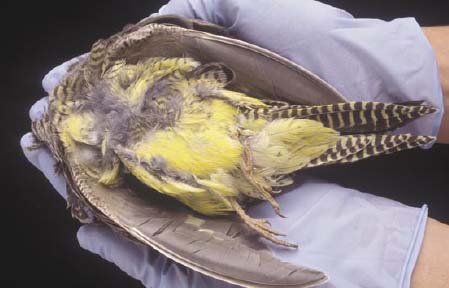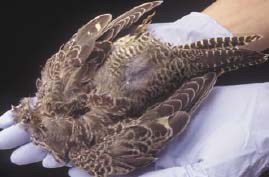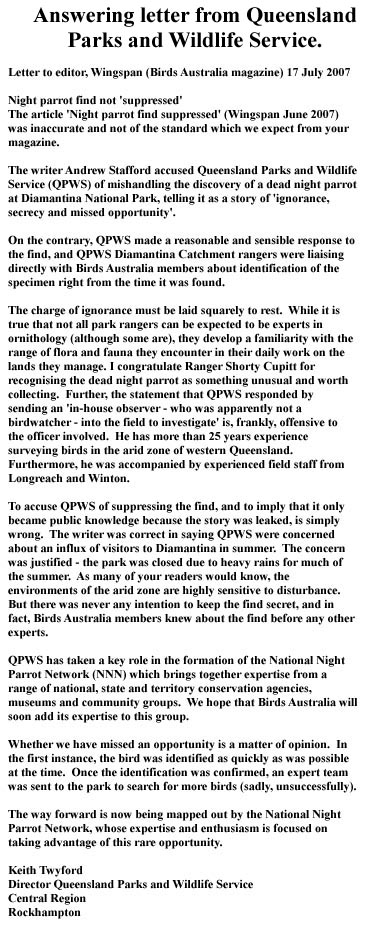
ON SATURDAY 17 September 2006, Robert ‘Shorty’ Cupitt, the ranger-on-duty of Diamantina National Park in south-west Queensland, was grading an interior road of the reserve when the blade of his vehicle exposed the yellow underbelly of a bird he didn’t recognise. As it eventually transpired, it was a deceased Night Parrot— only the second specimen to be found in nearly 100 years.
Depending on how long the headless, desicated bird had lain by the side of the road, this suggests the Night Parrot may be a winter breeder— not unexpected for a desert-adapted species. The sparsely vegetated gibber plain on which the bird was found has led some to conclude that it may have been flying to water when it collided with a barbed-wire fence (from which feathers were later recovered). Water was available some 5 km from the location.
More questions than answers
 Sadly, in a manner befitting one of the world’s most mysterious birds, the discovery has raised more questions than answers. What happened after the specimen’s discovery is a story of ignorance, secrecy and missed opportunity. First, the ranger, although familiar with the majority of birds in his area, was unable to identify the species. It was initially taken back to base at Diamantina where it was shown to Andrew Kingston, ranger of nearby Bladensburg National Park. He was also unable to identify the bird. (This is not to criticise the rangers, who are not and cannot be expected to be trained ornithologists, although a poster advertising the rarity of the Night Parrot existed in the ranger’s headquarters at nearby Astrebla Downs National Park.)
Sadly, in a manner befitting one of the world’s most mysterious birds, the discovery has raised more questions than answers. What happened after the specimen’s discovery is a story of ignorance, secrecy and missed opportunity. First, the ranger, although familiar with the majority of birds in his area, was unable to identify the species. It was initially taken back to base at Diamantina where it was shown to Andrew Kingston, ranger of nearby Bladensburg National Park. He was also unable to identify the bird. (This is not to criticise the rangers, who are not and cannot be expected to be trained ornithologists, although a poster advertising the rarity of the Night Parrot existed in the ranger’s headquarters at nearby Astrebla Downs National Park.)
From there, the bird returned to Winton, where at some point in the ensuing weeks it was shown to the owner of Tattersall’s Pub. The publican had a very good idea of what the bird was, and thought the specimen would make a fine tourist attraction—if not at the pub itself then at the local council-run Matilda Centre.
Fortunately, at the same time, an employee of the Queensland Museum happened to be staying at the pub. He photographed the bird and the digital file was later sent to the museum’s Senior Curator of Vertebrates, Steve Van Dyck. From this point, the story becomes murkier. Perhaps due to the enthusiasm of the locals to hang on to (and thus claim due credit for) their discovery, it took some persuasion on Van Dyck’s part to convince the Queensland Parks and Wildlife Service (QPWS)—who had recently been burned after publicly backing a claim, since discredited, of a new species of fig-parrot in the State’s south-east—to hand over the specimen.
This eventually happened on condition of confidentiality, something which was stressed upon seemingly everyone to have come into contact with information regarding the bird. Thus silence over the Night Parrot’s rediscovery reigned until 16 February 2007, when Greg Roberts (of The Australian newspaper) broke the story. By this stage, the bird’s trail was long since cold. To be fair, its identity was not confirmed until early November, by which time travellers to the Diamantina could have expected extremely hot weather and the imminent threat of wet-season rainfall, which can make much of the park impassable overnight.
It is not unreasonable that QPWS was concerned about an influx of excited birders into an unmanned park in such conditions. However, other aspects over the secrecy surrounding the specimen are disturbing. Although one representative of Birds Australia had been asked to assist in the specimen’s identification—again on a strict condition of confidentiality —the nation’s peak body for birds and birdwatchers remained otherwise uninformed.
This flies in the face of QPWS’s own recovery strategy for the species, which makes two recommendations: ‘(1) Continuing field searches in an effort to locate individuals; and (2) Alert ornithological societies and volunteer birdwatchers to the current status of this species, and encourage them to report all sightings, including as much detail as possible on habitat, possible threats and behaviour.’ This statement can be found on the Environmental Protection Agency/QPWS’s web page for the Night Parrot—last updated on 31 August 2006, less than three weeks before the specimen was found.
Lack of communication
Yet even more disturbingly, while QPWS had sent its own in-house observer—who was apparently not a birdwatcher—into the field to investigate, it still had no plans to inform Birds Australia, or any other ornithological group, at the time Roberts’ story broke. As might be expected, the observer failed to find any more parrots. Nor, at time of writing, have co-ordinated searches between Birds Australia and QPWS been planned. Incredibly, QPWS’s central regional director Keith Twyford told me that he did not believe it would be a prudent use of public resources to pour further public funds into finding Night Parrots. This is in spite of the fact that among QPWS’s stated reasons for keeping news of the discovery quiet was that they feared trappers might have attempted to collect birds and/or their eggs—surely a negligible risk to a species that is almost never seen, let alone smuggled.
At any rate, the Night Parrot can hardly be adequately protected until its habits and requirements are better understood. This demands that the birds must be reliably located. Just as core ranges and habitats for elusive species such as the Chestnut-breasted Whiteface, Princess Parrot, Marbled (Plumed) Frogmouth and many others were eventually found, we may be close to beginning to unravel the secrets of the Night Parrot: it’s a matter of cracking the code. Unfortunately the secrecy surrounding Shorty Cupitt’s amazing find represents a lost opportunity for all concerned: for QPWS, which could have built on the massive positive publicity generated by the discovery of the Boulia bird in 1990; for Birds Australia, so conspicuously left out in the cold; and of course for the poor Night Parrot itself, which at least we now know is still out there. Somewhere.
